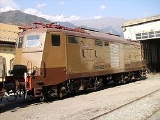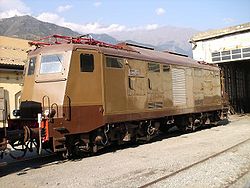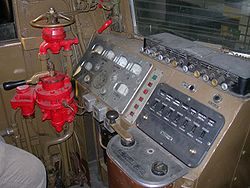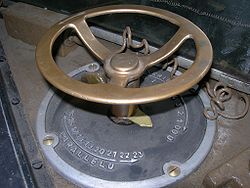
FS Class E424
Encyclopedia
The FS
E424 is a class of Italian railways electric locomotive
s. They were built in 1943-1951 and have been decommissioned in 2008.
as early as in the 1930s, but the project had been halted by the introduction of the E326
and E428
. After the realization of the 6-axle E636
, it was however decided to revamp the project by adapting to it some solutions already in use on the E636 (engines, bogies, suspension etc).
Breda SpA
workshop provided the three prototypes of E424 in 1943-1944. Mass production, however, could begin only after the end of World War II
, part of the funds provided by the United Nations Relief and Rehabilitation Administration
program.

 Class E424, having DC type motors, and like all the Italian locomotives of the time, is a rheostatic-type locomotive; on start, a rheostat is connected in series to the motors and is gradually excluded as speed builds up allowing more current to flow to the motors; but unlike other rheostatic locomotives of that time, this is not achieved via the characteristic lever (Maniglione), but through an automatic system, called Avviatore Automatico, derived from contemporary first-generation ALe 790/880/883 EMUs.
Class E424, having DC type motors, and like all the Italian locomotives of the time, is a rheostatic-type locomotive; on start, a rheostat is connected in series to the motors and is gradually excluded as speed builds up allowing more current to flow to the motors; but unlike other rheostatic locomotives of that time, this is not achieved via the characteristic lever (Maniglione), but through an automatic system, called Avviatore Automatico, derived from contemporary first-generation ALe 790/880/883 EMUs.
The driver simply selects the combination (series or parallel), and the relative rheostat contactors are automatically and gradually closed by this system; in case of failure, the driver can manually rotate an apposite wheel (that also usually rotates automatically as the system advances) to proceed with the exclusion.
When the rheostat is completely excluded for the series combination, field shunts can be inserted, or the driver can proceed to parallel combination, making a transition, which is handled by a device called "CEM" that automatically combines the motors (closing various contacts) accordingly.
 Originally more than one unit could be coupled and be controlled remotely by the first locomotive using a system called Comando Multiplo; on the central part of the cab there also was a door that enabled the crew to pass from one locomotive to another in case of problems. However, because of safety issues and the imperfect reliability of this system (there were no instruments indicating the status of the slave locomotive, so it wasn't certain if it correctly made a transition or not, for example), it was abandoned and then disassembled.
Originally more than one unit could be coupled and be controlled remotely by the first locomotive using a system called Comando Multiplo; on the central part of the cab there also was a door that enabled the crew to pass from one locomotive to another in case of problems. However, because of safety issues and the imperfect reliability of this system (there were no instruments indicating the status of the slave locomotive, so it wasn't certain if it correctly made a transition or not, for example), it was abandoned and then disassembled.
Eleven units received compound-type motors, enabling a very fine speed control, in a range included between 25 and 50 km/h in series combination, and 50 - 100 km/h in parallel.
FS
FS, fS, and fs may refer to:-Computing & technology:* Formula Student, a student engineering competition held annually in the UK* File Separator, a character in the C0 and C1 control codes* File server, a form of disk storage...
E424 is a class of Italian railways electric locomotive
Electric locomotive
An electric locomotive is a locomotive powered by electricity from overhead lines, a third rail or an on-board energy storage device...
s. They were built in 1943-1951 and have been decommissioned in 2008.
History
A design for a small multi-service Bo-Bo locomotive, with speed up to 90 km/h, had been devised by Giuseppe BianchiGiuseppe Bianchi (engineer)
Giuseppe Bianchi was an Italian railway engineer on the Ferrovie dello Stato between 1913 and 1946.-Life:Born at Imola, Bianchi graduated in electrical mechanical engineering at the University of Turin in 1912...
as early as in the 1930s, but the project had been halted by the introduction of the E326
FS Class E326
The FS E326 was a class of Italian railways electric locomotives. Designed in 1929, they were introduced in the early 1930s, for hauling passenger trains at relatively high speed.-History:...
and E428
FS Class E428
The FS E428 was a class of Italian railways electric locomotives. They were introduced in the course of the 1930s, for fast services on the Florence-Rome line, being decommissioned in the 1980s.-History:...
. After the realization of the 6-axle E636
FS class E636
The FS E636 is a class of Italian articulated electric locomotives. They were introduced in the course of the 1940s until the 1960s, and have been decommissioned in 2006. They have been one of the most numerous Italian locomotive group, and have been widely employed during their long career,...
, it was however decided to revamp the project by adapting to it some solutions already in use on the E636 (engines, bogies, suspension etc).
Breda SpA
Società Italiana Ernesto Breda
Società Italiana Ernesto Breda, more usually referred to simply as Breda was an Italian mechanical manufacturing company founded by Ernesto Breda in Milan in 1886. The firm originally manufactured locomotives and other railway machinery, but later branched out into armaments and aircraft. In 1962,...
workshop provided the three prototypes of E424 in 1943-1944. Mass production, however, could begin only after the end of World War II
World War II
World War II, or the Second World War , was a global conflict lasting from 1939 to 1945, involving most of the world's nations—including all of the great powers—eventually forming two opposing military alliances: the Allies and the Axis...
, part of the funds provided by the United Nations Relief and Rehabilitation Administration
United Nations Relief and Rehabilitation Administration
The United Nations Relief and Rehabilitation Administration was an international relief agency, largely dominated by the United States but representing 44 nations. Founded in 1943, it became part of the United Nations in 1945, was especially active in 1945 and 1946, and largely shut down...
program.
Series
The locomotives have been built in four series starting from year 1943:
- 001-003, prototype units with 32R-200 motors, 21/65 gear ratio, max speed 100 km/h and 2 field shunts; unit 003 had 20/65 gear ratio, for a maximum speed of 120 km/h, and also had compound-type motors (model 92-250).
- 004-013, compound-type 92-250 motors (as unit 003), max speed 100 km/h, 19/65 gear ratio.
- 014-038 and 057-078: units from 017 to 020 plus unit 022 and 024 were identical to units 001/2; units 014, 023, 025, 057 and 060 had 19/65 gear ratio that enabled the locomotives to reach 120 km/h; all the others had 92-250 motors, 2 field shunts, 16/65 gear ratio for a max speed of 100 km/h. Units from 039 to 056 and from 079 to 158 had the same motors and gear ratio as the latters, but 5 field shunts, except for unit 136 that had 19/65 gear ratio (max speed 120 km/h). Unit 068 was transformed, from November 1954 to May 1974, into unit E434-068: this unit had 4 double 82-333 motors, 2 shunts and 110 km/h-able 20/69 gear ratio; they have been used as experiments for the following FS Class E646FS class E646The FS E645 and E646 are two classes of similar electric locomotives used on Italian railways. They were introduced during the 1950s and they have been retired in 2009.- History :...
locomotives.
- Series 200 units: Starting from 1986, to 1993, 105 units have received an automatic fire extinguishing system, anti-slip device, red and green lights and the 78-wire cable to permit remote control for use with commuter trains, and maximum speed was raised to 120 km/h. These units are also referred to as E424N, where "N" stands for "Navetta" (push-pull); also, number 200 has been added to units' serial number (i.e. E424.116 became E424.316).
Technique

The driver simply selects the combination (series or parallel), and the relative rheostat contactors are automatically and gradually closed by this system; in case of failure, the driver can manually rotate an apposite wheel (that also usually rotates automatically as the system advances) to proceed with the exclusion.
When the rheostat is completely excluded for the series combination, field shunts can be inserted, or the driver can proceed to parallel combination, making a transition, which is handled by a device called "CEM" that automatically combines the motors (closing various contacts) accordingly.

Eleven units received compound-type motors, enabling a very fine speed control, in a range included between 25 and 50 km/h in series combination, and 50 - 100 km/h in parallel.

